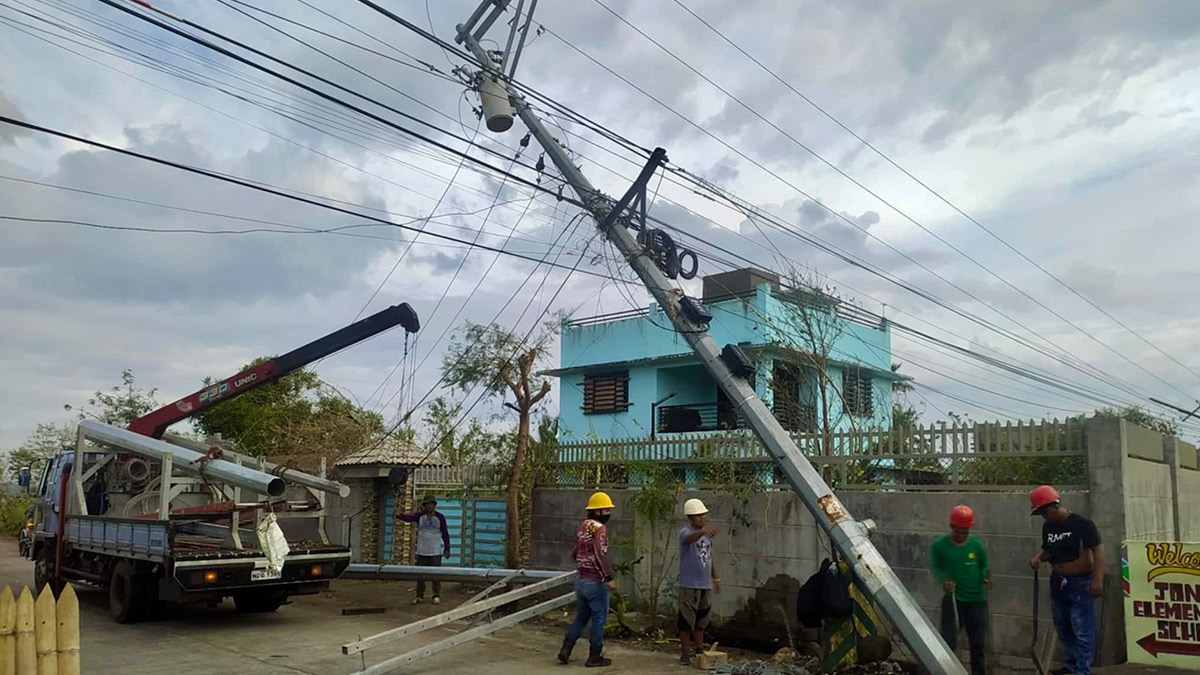
POWER RESTORATION Power restoration work continues in the town of Tiwi in Albay on Oct. 28, a week after strong rains and winds brought by Severe Tropical Storm Kristine (international name: Trami) caused a blackout in the geothermal energy-rich town. As of Thursday, only three of its 25 villages have their electricity restored. —TIWI MUNICIPAL GOVERNMENT PHOTO
Thousands of residents across the recently typhoon-battered Bicol region were to be evacuated on Friday night ahead of the onslaught of Typhoon Pepito (international name: Man-yi), which is projected to intensify into a supertyphoon before making landfall over the weekend. At 4 p.m. on Friday, Pepito was packing winds of up to 150 kilometers per hour, with gusts of up to 185 kph.
President Marcos also ordered government agencies to issue “worst-case scenario” warnings to sufficiently alert the public amid fears over Pepito’s impact. “Prepare the worst-case scenario in case Pepito intensifies, so people know what the situation will be in their area,” Marcos said during a situation briefing in Camp Aguinaldo on Friday afternoon.
READ: Pagasa warns: Pepito a very dangerous cyclone
The Philippine Atmospheric, Geophysical and Astronomical Services Administration (Pagasa) said Pepito is seen to move west-northwest from the east of Guian, Eastern Samar, and cut across parts of Luzon and Visayas.
Storm surge, lahar alerts
Based on its “cone of probability,” or the forecasted typhoon track, the state weather bureau did not rule out the possibility of Pepito making another landfall in various provinces, like Quezon, Pangasinan, Northern Samar, Sorsogon, Albay, Camarines Sur, and somewhere in Bicol and Central Luzon regions.
“It might make a landfall somewhere in Catanduanes by early Sunday morning before it makes another landfall on Polillo Island or on the mainland of Quezon province. And then by early Monday, it would pass by parts of Central Luzon and northern Luzon,” Pagasa assistant weather service chief Chris Perez said.
Across Bicol, Roberto Monterola, assistant chief of the Provincial Disaster Risk Reduction and Management Office in Catanduanes, said about 150,000 people from vulnerable coastal communities were to be evacuated. He said operation centers in the region have been on red alert since Severe Tropical Storm Kristine (Trami) hit on Oct. 21.
In Albay, Dante Baclao, head of the Public Safety and Emergency Management Office, reported that around 500,000 individuals had been evacuated due to threats of strong winds, storm surges, flooding, landslides, and lahar flows from Mayon Volcano. This included 51,368 families, or 172,258 people, in 11 towns and cities.
The Land Transportation Office suspended bus and public utility vehicle trips to the Visayas and Mindanao to avoid congestion at Matnog Port in Sorsogon. As of noon Friday, the Philippine Coast Guard reported 992 stranded passengers, 320 rolling cargoes, 21 vessels, and two motorboats across various ports in the region.
Remember ‘Yolanda’
In Nothern Samar, residents especially in towns facing the Pacific Ocean, were advised to be on alert for possible storm surges. Among these towns were Allen, Bobon, Capul, Catarman, Victoria, San Isidro, Laoang, Palapag Gamay, Mapanas, San Roque, Pambujan, San Jose, Mondragon, Lavezares, San Vicente and San Antonio.
The President said the public must not forget the storm surges that came with Supertyphoon “Yolanda” (Haiyan) in 2013 and that authorities and the public should prepare because they are “as fatal as a regular typhoon.”
“We have to get them to the high ground. It’s not enough to move them away from the sea … That’s the only thing that we can do when there is a storm surge,” he said.
Pagasa warned of moderate to high-risk possibility of storm surges reaching 3 meters in coastal areas in southeastern Quezon, Camarines Sur, Catanduanes, Albay, Sorsogon, northern Masbate, including Burias and Ticao Islands, Northern Samar, Eastern Samar, Samar, and northern Biliran.
The National Disaster Risk Reduction and Management Council said 149 local government units were placed under a storm surge warning, with 1,982,134 people at risk in 1,905 coastal barangays.
Storm warnings up
Pagasa has raised Signal No. 2 over the eastern portion of Northern Samar, northeastern part of Samar, and the northern side of Eastern Samar. Wind Signal No. 1 was raised over Aurora and Quezon, all Bicol provinces, parts of Eastern Visayas, Biliran province, and the rest of Northern Samar, Samar, and Eastern Samar.
Pepito is expected to bring “intense to torrential” rains of more than 200 millimeters to Bicol, while “moderate to heavy” rains are seen in Central Luzon, Calabarzon, and Eastern Visayas.
Marcos said the government has a very small window before Pepito hits land. “We have to reposition many of our assets to make sure that at least in the search and rescue phase that we are ready or we have our assets available,” the President said, referring to relief goods, air assets, heavy equipment, rubber boats, etc.
However, he assured that the government still has an adequate supply of food and other staples even if past typhoons damaged many crops. He added that the country will import close to 4.5 million tons of rice to help control the price of food amid the six typhoons that hit the country in three weeks. —With reports from Joey Gabieta, Ma. April Mier-Manjares and Villamor Visaya Jr.